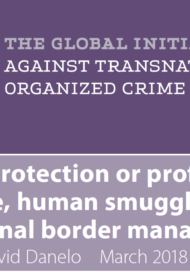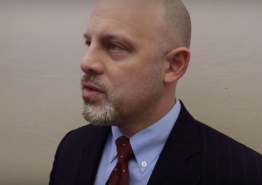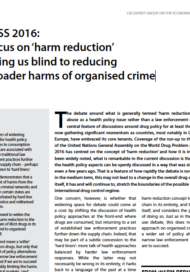Policymakers and interdiction authorities should allocate resources to the hierarchy of genuine border threats and risks as if it were an exercise in triage.
On 22 March, a spate of bombings in Texas ended when Mark Anthony Conditt, the man responsible for the attacks, killed himself with one of his devices. US authorities rightfully treated the week-long series of explosions as a major threat. Over 350 FBI special agents, in addition to hundreds of other officers, were deployed to Austin in response, amounting to what Texas Governor Greg Abbott called ‘an army of law enforcement’.
President Trump’s press secretary said the events had ‘no apparent connection to terrorism’, a perplexing case of double standards in the White House, unhelpfully suggesting the term should be reserved for incidents involving religious motives or coloured skin. If anything, the Austin bombings appear to have been a textbook case of domestic terrorism, much like the incident involving a hostage-taking gunman in Trèbes, whom French authorities confronted the following week.
For international security and supply-chain officials, the Austin explosions represented a nightmare scenario come to life. Since Christmas Day 2009, when Umar Farouk AbdulMutallab smuggled a bomb hidden in his underwear onto a flight (it failed to detonate), customs agencies have partnered with shipping companies to screen air cargo as far in advance as possible to prevent a ‘bomb in a box’ scenario.
Over the past decade, the equipment, technology and data exchanges established through the US Air Cargo Advance Screening (ACAS) programme and the European Union air cargo security regulations (often called the ‘EU ACC3 programme’) have been developed to stop explosive devices from entering the supply chain. Ironically, however, in the case of the Austin bombings, it was a stroke of good luck for authorities that one of the bombs exploded at a FedEx facility because investigators were able to immediately use the forensic explosive data obtained there to locate and target the serial bomber, ending a week of terror in less than a day.
Triaging security threats
These events raise an important question: for security practitioners, what should the priorities be when it comes to expending efforts and resources to interdict threats, actual or perceived, to national interests?
Politicians and policymakers would argue they need to stop everything unlawful – whether it’s a nuclear weapon, or narcotics, illicit cigarettes, counterfeit clothing, poached ivory or irregular migrants – from ever reaching an international border.
Practically speaking, however, the agencies involved are constrained by resources available, and enforcement efforts must be assigned by order of priority – much like with the medical process of triage. The technology and equipment that are used to detect nuclear and radiological weapons or explosives cannot also detect knock-off Rolex watches and Gucci handbags.
In terms of programme and equipment investments, customs authorities in both the US and the EU have largely prioritized detecting and preventing explosive, nuclear and radiological materials from entering supply chains. This is sound policy: bombs hidden in boxes are everyone’s problem. Preventing any forms of nuclear, radiological or conventional explosives from being detonated should be an endeavour that all politicians and policymakers support. Even though the Austin bomber briefly managed to overcome the system, stopping explosives at the point of origin remains the correct, practical priority for customs policies.
Highlighting the duality inherent in the security and revenue-generation functions of most border-control initiatives, which we highlighted in the policy brief For Protection or Profit, the next priority typically involves identifying illicit goods.
These can be anything from illegal narcotics to poached wildlife, or counterfeit textiles to contraband cigarettes. Identifying and seizing illicit goods are difficult tasks, and the detection processes involved vary. From a physical security perspective, detection efforts at ports of entry may include use of trained canines and searches of suspicious vehicles.
In terms of economic security, finding and seizing counterfeit goods are functions that multinational businesses want customs authorities to prioritize. Seizing non-declared goods may not matter for public safety, but it is nevertheless high on the priority list for many customs regimes, such as Mexico’s, which, for example, targets smuggled clothing.
Next in the hierarchy of priorities is the screening of people. Border-control officials, through intelligence networks, painstakingly monitor people who they believe are at risk of becoming radicalized and harming others. Interdicting people who fit this profile and pose a threat usually occurs through terror watch lists, which are used to screen people attempting to travel. In his book Understanding Terror Networks, Marc Sageman explains that an expressed enthusiasm for violence does not happen overnight, but slowly emerges among groups of participants sympathetic to a cause and at risk of radicalization. Using intelligence to identify the networks that pose the greatest security threats and screening them as far from an international border as possible (not to mention involving them in de-radicalization programmes where possible) are far more effective ways of expending limited security resources than the draconian approach of stopping all migrants or refugees from entering a country.
Then, finally, how should authorities deal with irregular migrants? Although migration is often conflated (inaccurately) with trafficking, many migration scholars, including Khalid Koser of the Brookings Institution, argue that the overwhelming percentage of migrants, including asylum seekers and refugees, pose no immediate security threat to receiving countries, and most are not victims of human trafficking.
Although right-wing politicians use militarized rhetoric about migration, the system works more effectively, not to mention humanely, when migrants are treated as the human beings they are rather than as the terrorists they are not. Such policies allow the authorities to focus more on the risk of actual threats than the imagined horrors of migration. If policymakers wish to reduce irregular migration, doing so long before migrants reach the borders of asylum states is by far a better strategy. Programmes such as France’s opening of asylum application centres in Niger may have their flaws, but, overall, they represent a more humane and practical effort than shoring up borders with more police.
Policymakers who wish to go beyond political rhetoric and are interested in what actually works in the interest of public security recognize that effective interdiction efforts require partnerships, collaboration and systemic resilience across borders and along supply chains. No technical solutions will provide a one-size-fits-all response.
This means being able to differentiate between a security threat (a bomb in a box) and contraband, which, although illegal, will not pose an immediate safety risk. From a migration perspective, it means acknowledging the significant distinction between terrorism, people smuggling and human trafficking.
Because most migrants fundamentally present no security threat, many forms of people smuggling do not involve transnational organized crime. People fleeing violence and poverty are just that, and policymakers responsible for interdicting criminals should be careful not to design systems that conflate migration with terrorism. Doing so, as the case of the Austin bomber illustrates, reduces their ability to identify the dangers of the latter while practically managing the complexities of the former.
Las prioridades deben dictar las políticas de control de fronteras
Políticos y autoridades responsables de interdicciones deberían asignar recursos contra las amenazas genuinas a sus fronteras como si se tratase de un proceso de triaje.
El 22 de marzo, un aluvión de explosiones en Texas terminó cuando Mark Anthony Conditt, el responsable de los ataques, murió tras hacer detonar uno de sus artefactos. Las autoridades estadounidenses trataron legítimamente las explosiones ocurridas durante la semana como una amenaza importante. Más de 350 agentes del FBI, además de cientos de otros oficiales, fueron desplegados en Austin, llegando a ser lo que el Gobernador de Texas, Greg Abbott, denominó “un ejército policial”.
El secretario de prensa del Presidente Trump sostuvo que los acontecimientos “no tuvieron relación aparente con el terrorismo”, un caso confuso de doble moral en la Casa Blanca que sugiere que el término debería ser reservado para incidentes que involucran motivos religiosos o piel de color. Si hay algo a lo que se parecen los ataques en Austin es a un manual de terrorismo doméstico, tanto como el incidente que involucró la toma de rehenes en Trèbes por parte de un individuo armado, a quien las autoridades francesas confrontaron a la semana siguiente.
Para los oficiales de seguridad en las cadenas de suministro, las explosiones en Austin fueron una pesadilla hecha realidad. Desde la Navidad de 2009, cuando Umar Farouk AbdulMutallab ingresó ilegalmente en un vuelo una bomba escondida en su ropa interior (que no logró detonar), las agencias de aduanas se han asociado con empresas de transporte con el objetivo de controlar los cargamentos aéreos por adelantado y así evitar situaciones en las que se llegue a transportar una bomba oculta en una caja.
Durante la última década, los intercambios de equipamiento, tecnología e información establecidos mediante el programa de los EEUU de Control Previo de Carga Aérea (ACAS) y las disposiciones sobre seguridad de cargamentos aéreos de la Unión Europea han sido desarrollados en miras a evitar que ingresen explosivos a la cadena de suministro. Irónicamente, en el caso de las explosiones en Austin, fue un golpe de buena suerte para las autoridades que una de las bombas detonara en una de las instalaciones de FedEx, ya que los investigadores pudieron utilizar inmediatamente la información forense obtenida en el lugar para localizar y dar con el atacante serial, poniendo fin en menos de un día a una semana de terror.
Priorizando las amenazas para la seguridad
De estos acontecimientos, surge una pregunta importante: para los profesionales de la seguridad, ¿cuáles deberían ser las prioridades al momento de destinar esfuerzos y recursos con el fin de interceptar amenazas, reales o percibidas, a los intereses nacionales?
Los políticos y legisladores argumentarían que deben evitar que cualquier cosa que esté por fuera de la ley alcance una frontera internacional, ya se trate de un arma nuclear, estupefacientes, cigarrillos de contrabando, indumentaria falsificada, marfil proveniente de la caza furtiva, o migrantes ilegales.
Sin embargo, en términos prácticos, las agencias involucradas se encuentran limitadas por los recursos disponibles, y los esfuerzos en materia de aplicación de las leyes deben ser asignados por orden de prioridad – como si se tratase del proceso de triaje que se realiza en el ámbito clínico. La tecnología y el equipamiento que se utilizan para detectar armas nucleares y radiológicas o explosivos no puede detectar también elementos falsificados, como un Rolex o un cartera de Gucci.
En lo que respecta a inversiones en programas y equipamiento, las autoridades de aduanas, tanto en los EEUU como en la UE, han priorizado en gran medida la detección y prevención del ingreso de materiales explosivos, nucleares y radiológicos a las cadenas de suministro. Se trata de una política sólida: las bombas ocultas en cajas son un problema de todos. Prevenir la detonación de cualquier forma de explosivos nucleares, radiológicos o convencionales debería ser un trabajo apoyado por todos los políticos y formuladores de políticas. Más allá de que el responsable de las bombas logró brevemente burlar el sistema, frenar los explosivos en el punto de origen sigue siendo la prioridad correcta y práctica para los oficiales de aduana.
La siguiente prioridad normalmente incluye la identificación de bienes ilícitos, lo que subraya la dualidad inherente a las funciones de seguridad y de generación de ganancias de la mayoría de las iniciativas, algo que resaltamos en el documento de políticas For Protection or Profit.
Estos bienes pueden ser drogas ilícitas, productos ilícitos de la vida silvestre, indumentaria falsificada o cigarrillos de contrabando. La identificación e incautación de bienes ilícitos son tareas difíciles, y el proceso de detección varía. Desde la perspectiva de la seguridad física, los esfuerzos en materia de detección en los puertos de ingreso pueden incluir el uso de perros adiestrados y el rastreo de vehículos sospechosos.
En términos de seguridad económica, las empresas multinacionales reclaman que las autoridades aduaneras prioricen el hallazgo y la incautación de bienes falsificados. Si bien la incautación de bienes no declarados puede no importar para la seguridad pública, está alta en la lista de prioridades para muchos regímenes aduaneros, como en el de México, el cual, por ejemplo, tiene el contrabando de indumentaria entre sus objetivos.
En la jerarquía de prioridades lo siguiente es la investigación de personas. Los oficiales de control de fronteras, mediante redes de inteligencia, monitorean meticulosamente a las personas que consideran que corren riesgos de radicalización y que pueden dañar a otros. Para la interceptación de personas que encajan en este perfil y comportan una amenaza, generalmente emplean listas de vigilancia contra el terrorismo, las cuales se utilizan para vigilar a personas que intentan viajar. En su libro Understanding Terror Networks, Marc Sageman explica que un entusiasmo explícito por la violencia no sucede de la noche a la mañana, sino que emerge lentamente entre grupos que apoyan una causa y que son potencialmente radicalizables. Hacer uso de información de inteligencia para identificar las redes que suponen las mayores amenazas para la seguridad e investigarlas lo más lejos de una frontera internacional posible (sin mencionar incluirlas en programas para sacarlas de la radicalización siempre que esté al alcance) son formas mucho más efectivas de invertir los limitados recursos para la seguridad que el enfoque draconiano de frenar a todos los migrantes o refugiados que intentan ingresar a un país.
Por último, ¿cómo deberían lidiar las autoridades con la migración irregular? A pesar de que la migración suele fundirse (erróneamente) con la trata, muchos académicos en la materia, entre los que se encuentra Khalid Koser de Brookings Institution, sostienen que el porcentaje abrumador de migrantes, incluyendo solicitantes de asilo y refugiados, no comporta ninguna amenaza inmediata sobre la seguridad en los países receptores, y la mayoría no son víctimas de la trata de personas.
Aunque los políticos de derecha emplean la retórica militar sobre la migración, el sistema funciona con mayor eficiencia, y más humanamente, cuando se trata a los migrantes como los seres humanos que son y no como los terroristas que no son. Políticas de este tipo les permiten a las autoridades centrarse más en las amenazas reales que en los horrores imaginarios de la migración. Si la intención es reducir la migración irregular, la mejor estrategia, por lejos, es hacerlo mucho antes de que los migrantes lleguen a la frontera de los países de asilo. Programas como los centros de solicitud de asilo de Francia en Niger pueden tener sus fallas, pero, en términos generales, representan un esfuerzo más humano y práctico que aumentar la presencia policial en las fronteras.
Los formuladores de políticas que desean ir mas allá de la retórica política y que están interesados en lo que realmente funciona en beneficio de la seguridad pública reconocen que para que las interceptaciones sean efectivas, se precisa de asociaciones, colaboraciones, y una resiliencia sistémica que atraviese las fronteras y que funcione a lo largo de toda la cadena de suministro. Ninguna solución técnica puede brindar una respuesta que funcione para todos.
Esto significa tener la capacidad de diferenciar entre una amenaza para la seguridad (una bomba en una caja) y un producto de contrabando, el cual, si bien es ilegal, no constituye un riesgo inmediato sobre la seguridad. Desde la esfera de la migración, significa reconocer la importante distinción entre terrorismo, tráfico ilícito de personas, y trata de personas.
Porque la mayoría de los migrantes básicamente no plantean una amenaza para la seguridad, muchas formas de tráfico ilícito de personas no implican delincuencia organizada transnacional. La gente que huye de la violencia y de la pobreza son sólo eso, y los políticos responsables de la interceptación de delincuentes deberían ser cuidadosos de no diseñar sistemas que mezclen migración con terrorismo. Hacerlo, como lo ilustra el caso del atacante de Austin, reduce las habilidades de identificar los peligros del terrorismo y de gestionar las complejidades de la migración.



